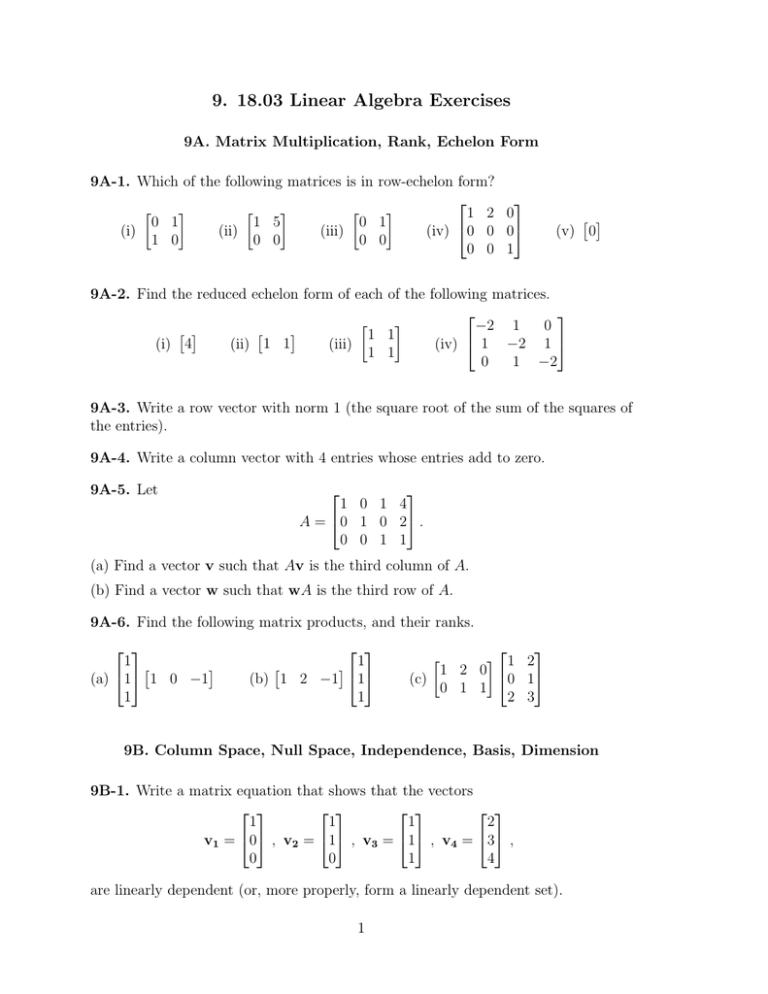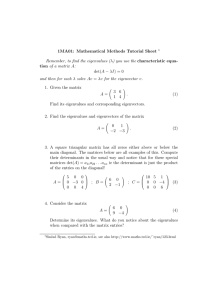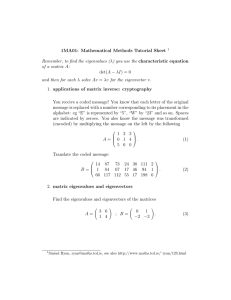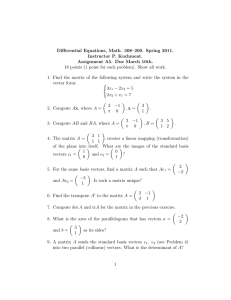9. 18.03 Linear Algebra Exercises
advertisement

9. 18.03 Linear Algebra Exercises 9A. Matrix Multiplication, Rank, Echelon Form 9A-1. Which of the following matrices is in row-echelon form? 1 2 0 0 1 1 5 0 1 (i) (ii) (iii) (iv) 0 0 0 1 0 0 0 0 0 0 0 1 (v) 0 9A-2. Find the reduced echelon form of each of the following matrices. −2 1 0 1 1 (i) 4 (ii) 1 1 (iii) (iv) 1 −2 1 1 1 0 1 −2 9A-3. Write a row vector with norm 1 (the square root of the sum of the squares of the entries). 9A-4. Write a column vector with 4 entries whose entries add to zero. 9A-5. Let 1 0 1 4 A = 0 1 0 2 . 0 0 1 1 (a) Find a vector v such that Av is the third column of A. (b) Find a vector w such that wA is the third row of A. 9A-6. Find the following matrix products, and their ranks. 1 (a) 1 1 0 −1 1 1 (b) 1 2 −1 1 1 1 2 1 2 0 0 1 (c) 0 1 1 2 3 9B. Column Space, Null Space, Independence, Basis, Dimension 9B-1. Write a matrix equation that shows that the vectors 1 2 1 1 v1 = 0 , v2 = 1 , v3 = 1 , v4 = 3 , 0 0 1 4 are linearly dependent (or, more properly, form a linearly dependent set). 1 9B-2 (a) Find a basis for the null spaces of the following 0 1 0 1 2 3 1 2 A = 1 2 3 4 , AT = 2 3 2 3 4 5 3 4 matrices. 2 3 4 5 (First find the reduced echelon form; then set each free variable equal to 1 and the others to zero, one at a time.) Note: The second matrix is the transpose of the first: that is the rows become the columns and the columns become the rows. T T (b) Find the genaral solutions to Ax = 1 1 1 and AT y = 1 1 1 1 . 9B-3 Find a basis for each of the following subspaces of R4 . Do this in (ii) and (iii) by expressing the subspace as the null space of an appropriate matrix, and finding a basis for that null space by finding the reduced echelon form. In each case, state the dimension of this subspace. (a) All vectors whose entries are all the same. (b) All vectors whose entries add to zero. x1 x2 (c) All vectors x3 such that x1 + x2 = 0 and x1 + x3 + x4 = 0. x4 9B-4 (a) For which numbers c and d 1 0 0 does the column space of the matrix 2 5 0 5 0 c 2 2 0 0 d 2 have dimension 2? (b) Find numbers c and d such that the 1 2 0 0 0 0 null space of the matrix 5 0 5 c 2 2 0 d 2 is 3-dimensional. 9C. Determinants and Inverses 2 Summary of properties of the determinant (0) det A is a number determined by a square matrix A. (1) det I = 1. (2) Adding a multiple of one row to another does not change the determinant. (3) Multiplying a row by a number a multiplies the determinant by a. (4) det(AB) = det(A) det(B). (5) A is invertible exactly when det A 6= 0. Also, if you swap two rows you reverse the sign of the determinant. cos θ − sin θ 9C-1 Let R(θ) = sin θ cos θ (a) Compute R(α)R(β). The claim is that it is R(γ) for some angle γ. (b) Compute det R(θ) and R(θ)−1 . 9C-2 Compute the determinants of the following matrices, and if the determinant is nonzero find the inverse. 1 0 0 0 1 a b 0 1 1 0 2 0 0 1 a (c) 1 0 1 (d) (a) (b) 0 1 c 0 0 3 0. 0 1 0 0 1 1 1 0 0 0 0 4 9D. Eigenvalues and Eigenvectors 9D-1 (a) Find the eigenvalues and eigenvectors of the matrices A = 3 0 B= . 1 4 1 1 and 0 2 (b) In LA.5 it was pointed out that the eigenvalues of AA are the squares of the eigenvalues of A. It’s not generally the case that the eigenvalues of a product are the products of the eigenvalues, though: find the eigenvalues of AB. (c) If you know the eigenvalues of A, what can you say about the eigenvalues of cA (where c is some constant, and cA means A with all entries multiplied by c)? (d) In (c) you have computed the eigenvalues of A + A (think about it!). On the other hand, check the eigenvalues of A + B for the matrices A and B in (i). 9D-2 Find the characteristic polynomial pA (λ) = det(A − λI) of each of the matrices in 9C-2. 9D-3 Suppose A and B are square matrices with eigenvalues λ1 , . . . λm and µ1 . . . µn . A 0 What are the eigenvalues of ? 0 B 3 9D-4 Suppose A and B are n × n matrices. Express the eigenvalues of the 2n × 2n 0 A matrix in terms of the eigenvalues of an n × n matrix constructed out of A B 0 and B. 9E. Two Dimensional Linear Dynamics 9E-1 Diffusion: A door is open between rooms that initially hold v(0) = 30 people and w(0) = 10 people. People tend to move to the less crowded. Let’s suppose that the movement is proportional to v − w: v̇ = w − v , ẇ = v − w (a) Write this system as a matrix equation u̇ = Au: What is A? (b) Find the eigenvalues and eigenvectors of this matrix. (c) What are v and w at t = 1 (d) What are v and w at t = ∞? (Some parties last that long!) 0 1 9E-2 (a) Find all the solutions to u̇ = u which trace out the circle of radius −1 0 1. 0 1 1 (b) Find all solutions to u̇ = u whose trajectories pass through the point . 1 0 1 F. Normal modes d4 x = cx. (In this 1D example, a normal dt4 mode is just a periodic solution. Constant functions are periodic (of any period; they just don’t have a minimal period).) Your answer will depend upon c. 9F-1 Find the normal modes of the equation 9G. Diagonalization, Orthogonal Matrices 9G-1 Suppose that A is a 10 × 10 matrix of rank 1 and trace 5. What are the ten eigenvalues of A? (Remember, eigenvalues can be repeated! and the trace of a matrix, defined as the sum of its diagonal entries, is equally well the sum of its eigenvalues (taken with repetition).) 9G-2 (a) Diagonalize each of the following matrices: that is, find an invertible S and a diagonal Λ such that the matrix factors as SΛS −1 . 1 2 1 1 A= , B= 0 3 3 3 4 (b) Write down diagonalizations of A3 and A−1 . 9G-3 A matrix S is orthogonal when its columns are orthogonal to each other and all have length (norm) 1. This is the same as saying that S T S = I. Think about why this is true! −2 1 Write the symmetric matrix A = as SΛS −1 with Λ diagonal and S orthog1 −2 onal. 9H. Decoupling 9H-1 Decouple the rabbit model from LA.7: what linear combinations of the two rabbit populations grow purely exponentially? At what rates? Does the hedge between the two fields have any impact on the combined population? 9I. Matrix Exponential 9I-1 The two farmers from LA.7 and problem 9H-1 want to be able to predict what their rabbit populations will be after one year, for any populations today. They hire you as Write down an a consultant. explicit matrix which tells them how to x(t0 + 1) x(t0 ) compute in terms of . You can leave the matrix written as a y(t0 + 1) y(t0 ) product of explicit matrices if that saves you some work. 0 1 At 9I-2 Compute e for A = . −2 −2 9J. Inhomogeneous Systems 9J-1 Find particular solutions to the following systems using the exponential response formula (That is, guess a solution of the form eat v.) 6 5 2t 1 (a) u̇ = u+e . 1 2 2 1 0 1 (b) u̇ = u + cos(2t) . 1 2 0 9J-2 Farmer Jones gets his gun. As he gets madder he shoots faster. He bags at the rate of et rabbits/year rabbits at time t. We’ll see what happens. 3 1 In our work so far we have found S and Λ so that the rabbit matrix A = 2 4 −1 At Λt −1 −1 factors as SΛS . So e = Se S . The final S adjusts the fundamental matrix 5 Φ(t) = SeΛt to give it the right initial condition. If you don’t care about the initial condition, Φ(t) is good enough. t e Use it in a variation of parameters solution of the equation u̇ = Au − with initial 0 1 condition u(0) = . Begin by finding some particular solution (without regard to 0 initial condition). If you are careful, and keep your matrices factorized, you can use matrices with just one term (rather than a sum) in each entry. 6 M.I.T. 18.03 Ordinary Differential Equations 18.03 Extra Notes and Exercises c Haynes Miller, David Jerison, Jennifer French and M.I.T., 2013 1







